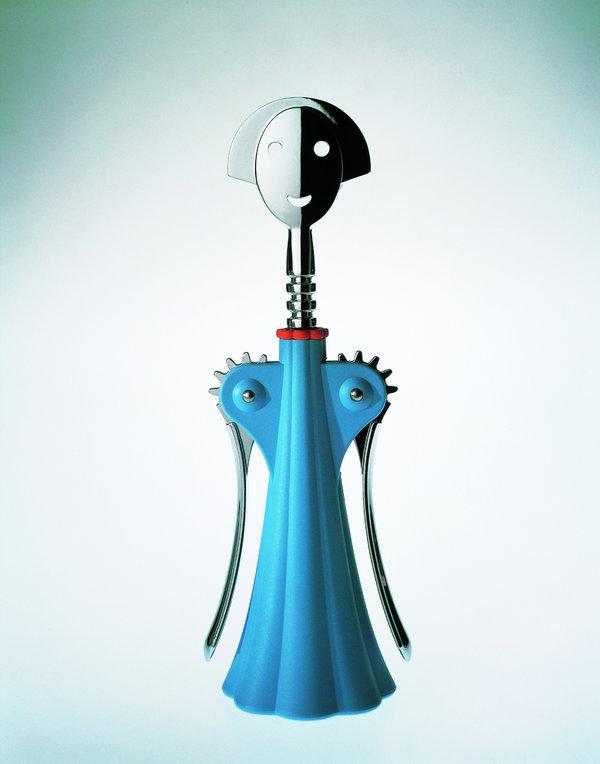“I have, sometimes, problems with my objects,” Alessandro Mendini, the Italian designer, architect and editor, once admitted. “Sometimes my objects are aggressive even to me.”
Aggressive, brash, free-spirited — those words and more have been applied to Mr. Mendini’s work, large and small.
There was, for instance, the Sirfo table (1986), a small side table whose base was in the shape of a goose. There was the bus stop he created in Hannover, Germany, in 1992, an eye-popping checkerboard design in black and yellow with golden turrets.
And there was his best-known creation, the Proust armchair, an over-the-top evocation of something that he thought Marcel Proust might have relaxed in while remembering things past. Like many of Mr. Mendini’s works, it mixed two somewhat incongruous influences: It’s an oversize Baroque armchair but decorated in a pointillism reminiscent of the artist Paul Signac.
Mr. Mendini made the chair in 1978, when he was part of Studio Alchimia, a group of designers rebelling against what they viewed as the coldness of modernist design. He had both admirers and detractors.
“All my objects are like characters,” Mr. Mendini told the art and architecture magazine Dezeen in 2015. “One is good, another one is bad. It’s a kind of comedy and tragedy.”
Mr. Mendini died on Feb. 18 in Milan. He was 87. Atelier Mendini, the architectural firm he founded with Francesco Mendini, his brother, posted news of his death on Facebook.

Among Mr. Mendini’s most famous designs was the Anna G. corkscrew, which he said was inspired by Anna Gili, a friend and fellow designer.CreditAlessi
Alessandro Mendini was born into a prominent family in Milan on Aug. 16, 1931. He earned an architecture degree in 1959 from the Politecnico di Milano and worked for the architect and designer Marcello Nizzoli before striking out on his own.
He worked on a number of prominent projects, including the Groninger Museum in the Netherlands, which opened in 1994, for which he was lead architect. He invited several other architects to design separate pavilions for the museum, resulting in, as one travel website puts it, “a postmodern masterpiece, or a postmodern monstrosity, depending on who you ask.”
His other architectural works include the Ceramics Museum and Exhibition Complex in Incheon, South Korea, and factories in Omegna, Italy, for Alessi, the housewares manufacturer. He designed numerous products for Alessi over the years, among the most famous being the Anna G. corkscrew, a whimsical tool with a feminine shape that he said was inspired by Anna Gili, a friend and fellow designer.
“I remembered as a child when my grandmother would open a bottle of wine at the table it always seemed like a good performance, a kind of ritual ballet: the turning of the head, the arms moving up and down, the sound of the cork popping from the bottle,” he told The Financial Times in 2016. “That’s when I decided on an anthropomorphic object. I made a drawing of a ballerina, a female figure. It was evident, though, that I had subliminally drawn a portrait of Anna.”
The corkscrew came out in 1994 and was a success. It spawned related products, including an Alessandro M. corkscrew — a male version of the Anna — and an Anna pepper mill.
Mr. Mendini designed products for other companies as well, including Swatch and Samsung. He designed a skateboard for the gear and clothing line Supreme.
He also exerted considerable influence on the design world as an editor at several magazines, including Casabella, where he worked for six years beginning in 1970. That put him at the heart of Italy’s so-called radical design movement of the 1960s and ’70s.
“Casabella was amazing,” Paola Antonelli, a curator at the Museum of Modern Art, told W magazine in 2010. “Everything about it was so strong — the covers, the ideas, everything — because Mendini was always pushing it forward.”
For several years in the 1980s Mr. Mendini edited Domus, another important publication, which influenced, among others, the Australian designer Marc Newson, who read it when he was a student in Sydney.
“Domus was the bible,” he told W. “A couple of subscription copies were airfreighted in every month for a ridiculous amount of money. I used to ‘borrow’ them, and they were my windows into the world of design.”
Mr. Mendini’s ideas influenced the Memphis Group, an Italian collective of designers who produced attention-getting furniture in the early 1980s.
“I think the Milanese movements, Alchimia and Memphis, had a very important role in freeing design from the nightmare of functionalism and technicality, and in bringing design closer to the world of art,” Mr. Mendini told the British publication Metro in 2015. “They took place in the era of postmodernism, which favored a playful and anthropological approach.”
In addition to his brother, Mr. Mendini’s survivors include a sister, Mia, and two daughters, Fulvia and Elisa.
In a 1998 interview with The Globe and Mail of Canada, Mr. Mendini explained his penchant for ornate pieces in an era of the cool and sleek.
“I use a lot of decoration because I think decoration is one of the oldest things humanity did — before architecture, before object-making,” he said.
The word “ironic” was sometimes used to describe his work; he used it himself, in fact. In a 2011 interview with the architecture and design website Architonic, he explained why he thought works that provoked that description were in short supply in design.
“Irony is quite hard to come by,” he said. “And that is because irony is something that causes you to laugh at yourself. Not many people are willing to laugh at themselves, because everyone seems to think they are worth more.”







